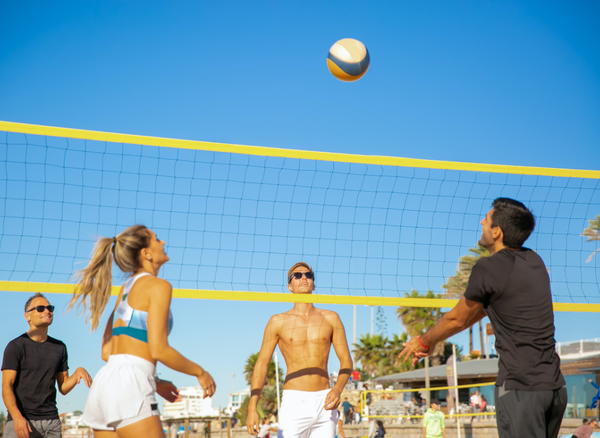Beach volleyball is a fantastic way to enjoy the sun, sand, and a bit of friendly competition. If you're a newbie, we'll help you understand the basics on how to play beach volleyball, score points, and have a blast while doing it.
The Basics of Beach Volleyball
Beach volleyball is played outdoors on a sand court, typically measuring 16 x 8 meters. Unlike indoor volleyball, which has six players per team, beach volleyball features two players per team.
The objective is simple:
Setting Up the Court
To set up a beach volleyball court, you'll need a net that stands 2.43 meters high for men and 2.24 meters high for women. The court is divided into two equal halves, with each team occupying one side. The end line marks the boundary at the back of each side of the court.
Serving and Scoring
The game begins with a coin toss to determine which team serves first.
In sideout scoring, only the serving team can score points, but in rally scoring, whichever team wins the rally scores a point.
The first team to reach 21 points with at least a two-point advantage wins the set.
If there's a need for a tiebreaker 3rd set, the first team to reach 15 points with at least a two-point advantage wins the match.
Play Starts with the Serve
The server stands behind the end line and hits the ball over the net to the opposing team. The opposing team receives the serve and tries to set up an attack.
Playing the Ball
Players can use any part of their body to hit the ball, but only the hand is commonly used.
A block counts as one of these contacts in beach volleyball.
Passing and Setting
The forearm pass, or bump, is used to receive the serve and pass the ball to the teammate. The teammate getting the pass typically would act as the setter uses a precise touch to set the ball for the other teammate; attacker. Good ball control is essential for effective passing and setting.
Attacking
Attack hits are used to spike; send the ball over the net, and score points. Players can spike, tip, or hit the ball with an open hand. The goal is to make the ball land on the opponent's court.
Blocking
Blocking is a defensive move where a player jumps near the net to prevent the ball from crossing to their side. A successful block can result in an immediate point if the ball lands on the opposing team's side.
Defense
Defensive strategies in beach volleyball include digging and diving to keep the ball in play. Players must be quick and agile to react to the opponent's play and prevent the ball from touching the sand.
Switching Sides
Teams switch sides every seven points to ensure fair play, considering factors like wind and sun. This keeps the game balanced and exciting. Teams switch sides every five points in the 3rd set.
Equipment
While you can play barefoot, sand socks are recommended to protect your feet from hot sand and sharp objects. A good quality volleyball is also essential for a great game. Don't forget to protect your eyes with a pair of sunglasses.
Common Mistakes
One common rookie mistake is making more than three contacts with the ball. Another is double contact, where a player hits the ball twice in succession. Both result in a point for the opposing team.
Famous Tournaments
The FIVB World Tour and the Olympic beach volleyball tournaments are the pinnacle of the sport. Watching these events can provide valuable insights and inspiration.
Playing Beach Volleyball FAQs
What is the difference between beach volleyball and indoor volleyball?
Beach volleyball is played outdoors on sand courts with two players per team, while indoor volleyball is played on a hard court with six players per team. The scoring system and some rules also differ.
How do you score points in beach volleyball?
Points are scored when the ball lands on the opposing team's side of the court, the opposing team commits a fault, or the opposing team fails to return the ball within three contacts.
What should I wear to play beach volleyball?
Wear comfortable athletic clothing, and consider sand socks to protect your feet. Sunscreen and sunglasses are also recommended.
Summary
Beach volleyball is a fun in the sun sport that combines skill, strategy, and physical fitness. By understanding the rules, practicing regularly, and respecting your opponents, you can enjoy a fantastic game on the beach.
Grab a ball, find a court, and start playing!








